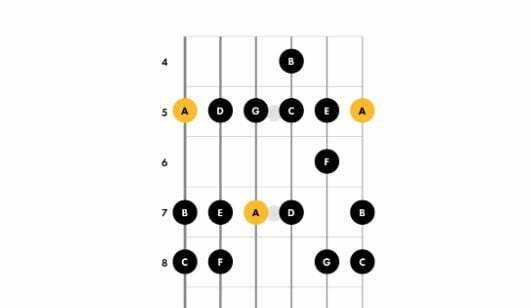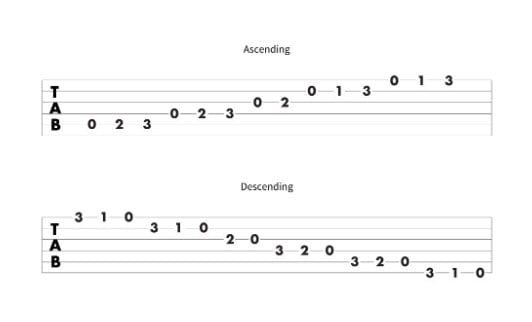How to Play the A Minor Scale on Guitar
Learning to play scales is an excellent way for guitarists to expand their abilities and understanding of music theory. The A minor scale, which has no sharps or flats, is a great scale for beginners to practice. By mastering this scale, beginners can hear each note in its purest form. This article will explain the notes that make up the scale and provide various ways to play it on the guitar. Let's begin!
Notes in the A Minor scale
The A minor scale is made up of these seven notes:
- A
- B
- C
- D
- E
- F
- G
The A minor scale has no sharps or flats, just like the C major scale. Interestingly, it uses the
same notes as the C major scale, but with A as its starting point. This means that A minor is the relative minor of C major. With this knowledge of the scale's notes, we will demonstrate where to place your fingers on the fretboard to play the A minor scale, note-by-note.
A Minor scale position
Guitar scale diagrams are an easy way to learn the A minor scale. These diagrams provide a visual representation of your guitar's fretboard. By learning how to read guitar charts and diagrams, you can better understand the notes and their corresponding frets, which will help you learn how to play scales.
In the following examples, each dot represents a note to play on a specific fret and string. An open string is indicated by a dot with a note above the string, indicating that no frets should be pressed down. The yellow dots indicate the root note of the scale. In these examples, each A note across the fretboard will be highlighted in yellow to show where the scale starts over again.
A minor scale - Open position
To play the A minor scale in open position, you only need to play notes on the first three frets of your guitar. Use your index finger for notes on the 1st fret, middle finger for notes on the 2nd fret, and ring finger for notes on the 3rd fret. While there are some notes in the scale on the 6th (low E) string, it may be best to start with the open A (5th string) to use the lowest possible A note as the root. From there, move up to the 2nd fret on the 5th string (B) and the 3rd fret (C).

A minor scale - 5th position
You can also play the A minor scale in the 5th position, which will allow you to hear the same notes in a higher register. To do this, start with your index finger on the 5th fret of the 6th (low E) string, which is another A note. Then, use your ring finger for the 7th fret of the same string and your pinky finger for the 8th fret.
It's important to note that when you reach the 3rd string, you'll need to shift your hand to move your index finger to the 4th fret. When you get to the 2nd string, your index finger will shift back to the 5th fret. Playing higher up on the fretboard will produce a different tone and feel.

A Minor Scale Tab
Using tabs to understand the notes of a scale in order is another approach to learning scales that may be more familiar to some guitar players. While the diagrams above provide a roadmap, tabs offer step-by-step directions, which some people find easier to understand. It's a good idea to understand both methods to determine which one works best for you.
Now, let's take a look at what the two positions we just reviewed would look like in tab form.
A minor scale- Open position tab
To play the A minor scale in open position, begin with the open A (5th) string, and follow the fret positions in the tab provided below as you move across the fretboard:

A minor scale- 5th position tab
To play the scale in 5th position, begin with your index finger on the 5th fret of the 6th (low E) string, and continue as follows. Remember to shift to the 4th fret for just the 3rd string, using your index finger as an anchor.

A minor scale exercises
Memorizing scales requires patience and repetition. Play through both A minor scale positions, ascending and descending, until you can confidently play the notes at a faster speed. You can also use a metronome to practice playing at a designated speed and improve your timing.
Once you become more familiar with the scale notes, you can use the pattern to practice other guitar techniques such as alternate picking or fingerpicking. You can also experiment with different rhythms or create your own riffs that incorporate notes from the scale.








